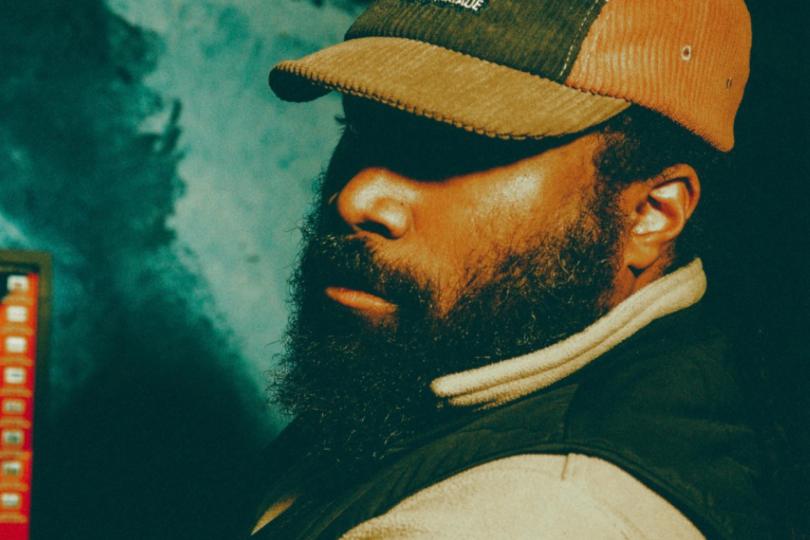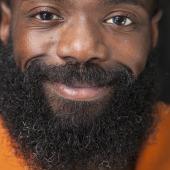Creative Discipline with Muralist Malcolm A. Rolling

My Creative Discipline series continues with Malcolm A. Rolling, a muralist whose recent artwork can be seen in bustling neighborhoods and substations in northern New Jersey. Rolling and I met at the National Black Theatre in Harlem at a short play festival featuring a cerebral play I had written inspired by the life and work of Basquiat. I ran into Malcolm at a gallery opening in Newark this summer, and we got a chance to talk about his creative process and some of the exciting projects he’s working on. In this article we discuss the familial roots of his aesthetic, how art revitalizes urban areas, and the collaborative nature of his work.
TS In a recent article I define Creative Discipline as the ability to complete a single project from idea to creation to development to production. However, it may also be defined as one’s creative practice e.g. cinematographer, dancer, or sculptor. How would you describe your creative discipline?
MR I’m a muralist, craftsman, educator, and COO of YENDOR. I see creative discipline as a way to lean on what I know creatively. Through practice and experience, I’ve developed methods and abilities that act as a safety net when I’m creating, guiding me and helping me overcome obstacles. This keeps me focused and ensures I see my work through completion.
TS What determines your interest as a creative?
MR My interest in art has been influenced by a variety of factors. I have been fortunate to learn from great teachers and have been exposed to a wealth of communal knowledge. They taught me about self-determination and creativity, which greatly impacted my formative years. As a result, I have been inspired to approach every aspect of my identity with discipline, character, and morality.
TS What are three things you cannot create without? And why?
MR. 1) iPad: Great for sketching out ideas, creating concept designs, making mock-ups, and even for communication purposes. It's a versatile tool that can be used for a variety of creative tasks. 2) Dry Erase Board: Perfect for brainstorming sessions, budget planning, and conducting meetings. It's a great way to visually map out ideas, track expenses, and collaborate with team members. 3) Paint: Ideal for mural production, whether it's for a large-scale project or a small art piece. It allows me to bring their vision to life and add a pop of color to any space.
TS Walk me through your creative process? How do you create? Can you identify a routine?
MR My creative process varies. Usually, I kick things off with the conceptualization phase. This stage is all about brainstorming ideas, conducting research, and coming up with a concept design that sets the tone for the project. It helps me establish a clear direction and plan of action before diving into the actual work. After finalizing and getting the design approved, I transition into the production phase. This is where the real magic happens, but it's also the most demanding part of the process. It requires meticulous coordination of various elements such as weather conditions during summer months, location logistics, and the scale of the project. Ensuring everything comes together seamlessly is crucial to bringing the creative vision to life. That’s why it is important to infuse the atmosphere with the right music and positive vibe to get the job done. So when we “hit the wall”, my team and I strive to build a vibrant and inclusive scene that encourages teamwork and collaboration that reflects our greater community.
“My creative inspiration stems from a profound belief in the traditions passed down through my family …”
TS Where does your inspiration come from?
MR My creative inspiration stems from a profound belief in the traditions passed down through my family, a genuine appreciation for black culture, and a strong desire to bring about social and political transformation through artistic expression. These elements serve as the foundation that allows me to stay connected to my authentic self whenever I engage in the creative process. As Tupac Shakur once said, "All good things come to those who stay true."
TS For whom do you create?
MR I take pride in the idea that my creative endeavors serve to unite the ‘who’, ‘what’, and ‘why’ in Creative Placemaking. In the public art space, Creative Placemaking is intricately linked to the revitalization of urban areas, and my contributions bring a layer of cultural richness to this process. Through ongoing education, I have gained a deep understanding of the cultural sensitivities involved in community activation, as well as the importance of rediscovering and identifying what the local community holds dear, whether it be internally or externally, and then expressing these sentiments through artistic means.
TS When do you know it’s time to abandon a project?
MR Abandon a project?! I NEVER ABANDON A PROJECT! It's very hard for me to abandon any of the projects I start. Unfortunately, I’ve only stepped away from a handful of projects due to insufficient funds or uncooperative partners; however, working in the public art scene, large-scale projects and their objectives are always so much grander than me, so I try to be intentional about following through.
“... my objective in producing public art always upholds a spirit of collaboration and teamwork.”
TS At what stage in your creative process do you invite collaborators?
MR Most of the projects I work on are collaborative right out of the gate; my objective in producing public art always upholds a spirit of collaboration and teamwork.
TS What creative obstacles do you face? Personal or professional.
MR Public art often faces challenges, with the main one now being the difficulty in finding partners who are willing to support the work. While many people appreciate murals, property owners have not been very open to having them on their buildings. This may be due to the increased popularity of murals affecting how the final result is perceived. Despite the obstacles, public art continues to thrive, with artists and communities finding ways to overcome challenges. It is important to work towards building partnerships with property owners and other stakeholders to ensure that public art can continue to enrich and beautify our surroundings.
“ … when obstacles appear, take a deep breath …”
TS What tips do you have for creatives who may be facing their own creative challenges?
MR Embrace the journey within your respective discipline; when obstacles appear, take a deep breath and reevaluate, but don't get lost in the minutia. Get active and trust the process for good or bad! There's a lesson to be learned from all of it, as long as you're honest with yourself, you’ll come out better.
TS What projects are you currently working on and where can our readers follow and find your work?
MR I usually keep my current projects under wraps until they're done, but I can say that my team and I have been working hard on a few substation artwork projects with PSE&G to bring quality art to different neighborhoods in Northern New Jersey. I'm hoping to take on more public art projects and grow the team at YENDOR. You can reach me via Instagram @m.rolling OR @yendor_llc OR yendorproductions.com.
Malcolm A. Rolling (COO of YENDOR) , a multifaceted artist, excels in reimagining studio, public, and educational arts into ‘Industrial Impressionism’, a unique practice where he repurposes industrial tools and mediums commonly found on the streets. His work, characterized by raw and unfiltered aesthetics, incorporates aerosol, ink, acrylic, airless sprayers, and found materials, showcasing a fusion of urban elements with traditional art techniques. Despite the raw nature of his art, Rolling's background in studio and mural production adds a refined touch to his creations. Leveraging his extensive experience in art production, Rolling’s street style and technique is a catalyst for community development, transforming his work into a powerful tool for social change.




